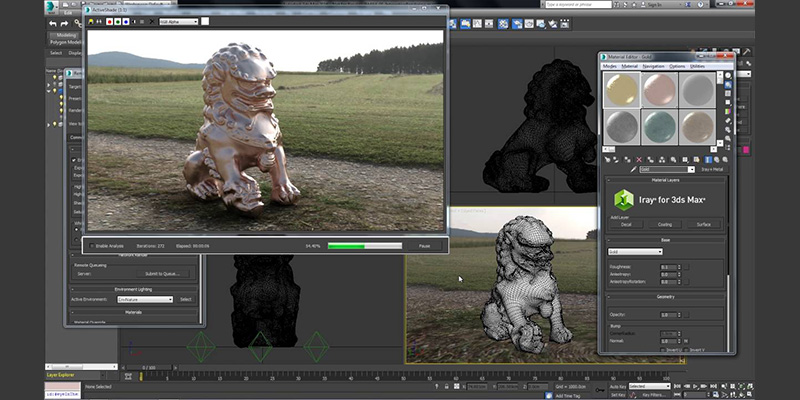3Ds Max is probably the 3D package with the most external rendering engines that can be integrated with it.
Today we will take a look at 13 of the best of 3Ds max Plugins for Rendering, and we are going to start the list with:
13- Radeon ProRender
ProRender formally known as FireRender is an OpenSource path-tracer from AMD. This 3ds Max plugin is developed by the Render Legion guys who created the famous Corona renderer. It is based on OpenCL, which benefits from AMD’s high-performance Radeon™ Rays technology.

ProRender is a powerful physically-based rendering engine. It can simultaneously use and balance the capabilities of multiple GPUs and CPUs – on the same system, at the same time.
Radeon ProRender is a free rendering plugin that comes with a library of materials you can use for free within 3Ds max.
12- Indigo Render

Indigo Renderer is an unbiased, GPU and CPU renderer that accurately simulates the physics of light. Indigo 4.2 was just released with a Brand new multi-GPU engine also Workflow & UI enhancements.
Indigo was originally released as freeware until the 2.0 release when it became a commercial product. The Indigo 3 series introduced many important features such as real-time editing capabilities, while version 4 of the software adds pure GPU rendering through a vendor-neutral OpenCL path tracing engine.
11- FurryBall

FurryBall is a 3Ds Max plugin for real-time GPU production quality. FurryBall RT offers advanced rendering techniques, implemented directly into 3ds Max with multi-GPU support. FurryBall was developed for in-house AAA studio purposes in 2009. FurryBall was used for rendering a whole feature movie, Goat Story 2 in 2008. It’s probably the first world rendered CGI feature movie for cinemas rendered only on GPUs.In 2015, the latest version of FurryBall RT was released with a completely rewritten core.
10- Arion Render

Arion is a hybrid CPU/GPU renderer. It is interactive and unbiased and progressive. There is a standalone application but there is also a plugin available for 3dsmax.
This plugin was created by Random control which is a Spanish company located in Madrid. They are the creators of Maverick rendering technology and ArionFX, a post-processing tool for HDR images.
9- Maxwell Render

Maxwell Render is an unbiased 3D render engine, developed by Next Limit Technologies in Madrid, Spain. This stand-alone software is used in the film, animation, and VFX industry, as well as in architectural and product design visualization
Maxwell Render was released to the public as an early alpha in December 2004 (after two years of internal development) utilizing a global illumination (GI) algorithm
Maxwell Render it trademark Multilight feature, which permits the changing of light intensity and colors in real-time, was used in the feature film The Curious Case of Benjamin Button.
Maxwell 5 marked the release of a completely rewritten rendering engine using GPU much faster than the previous CPU-only functionality. The new version also provides integrated cloud rendering for use across an internal network or third-party render farms.
8- Iray

NVIDIA Iray is a 3Ds Max Plugin for rendering accelerated on the GPU featuring photorealistic and physical precision. When combined with the parallel processing power of Nvidia graphics cards it reaches speed levels that reduce the iteration time of the scenes during the creative process.
Iray is good when it comes to ease of use during the configuration of the scenes with results of greater photographic realism and high interactivity.
Iray offers three rendering modes, which support a wide range of design needs, workflows, and content complexity:
- Iray Photoreal final production rendering with full global lighting support
- Interactive Iray Interactive and editable ray tracing
- Realtime Iray large display capability and in Real-Time Edition (optional)
Because the rendering modes share the same high-level scene description and the same materials, Iray is able to support the perfect image mix when switching between modes. The result is a uniform user experience
7- Final render

FinalRender is a 3D rendering engine developed by Cebas as a plugin for 3D Studio Max. FinalRender offers a lot of good tools to optimize global illumination for stills and animation. They have a very good and flexible system to render anything you want.
With Drop 3, we get more acceleration on both GPU AND CPU fina. It comes with a CPU-based Denoising technology. In addition to the latest NVIDIA RTX Denoising option. FinalRender also offers Intel’s Open Image Denoiser a CPU-based Ai -Denoiser.
6- FSTORMRENDER

FStrorm is a GPU plugin renderer for 3dsmax. Developed by Andrey Kozlov, it is a fast render engine that has many unique features such as improved tone mapping, light sampling, native BRDF model, glare effects, improved raytracer, and optimized QMC sampler. Kozlov was one of the main developers that worked for a company called OTOY which is the creator of Octane render, also he was responsible for implementing Octane into 3ds max.
Kozlov stopped working for OTOY and a year later in 2016 launched Fstormrender, after that he was sued by OTOY who claimed that he stole their code to create FstormRender, so they filed a lawsuit against him in Newzealand which led to the shutdown of FstormRender temporarily, then the case was continued in Russia which reversed the order and gave the right to Kozlov to sell FStormRender license that costs 20€ per month for one PC.
5- Arnold

Arnold is an unbiased, physically based, ray tracing 3D rendering application created by the company Solid Angle. Notable films that have used Arnold include Alice in Wonderland, Thor, Captain America, X-Men: First Class, The Avengers, Space Pirate Captain Harlock, Elysium, Pacific Rim, and Gravity.
The chief architect of Arnold is Marcos Fajardo. The beginnings of what is now Arnold emerged in 1997 when Marcos decided to write his own renderer.
Solid Angle, the company behind Arnold, was purchased by Autodesk in early 2016. The acquisition was announced officially on April 18, 2016.
4- Octane Render

Octane Render is an unbiased rendering application with real-time capability. It was created by New Zealand-based company Refractive Software, which was acquired by OTOY on March th13 2012. Version 1.0 was released on 28 November 2012; later versions of Octane Render continue to be deployed using Web release. Octane render was the first commercially available unbiased raytracer that fully utilized the GPU, giving it a significant speed advantage by allowing users to more easily modify scenes in real-time.
Octane Render runs exclusively on Nvidia’s CUDA technology, restricting it to Nvidia video cards; Octane Render 2019 is planned to run on Vulkan and therefore will be able to run on both AMD and Nvidia graphics cards.
3- Corona Renderer

Corona Renderer is a modern high-performance (un)biased photorealistic renderer, available for Autodesk 3ds Max and as a standalone application.
The development of Corona Renderer started back in 2009 as a solo student project of Ondřej Karlík at Czech Technical University in Prague. Corona has since evolved to a full-time commercial project after Ondřej established a company together with the former CG artist and an associate professor and researcher at Charles University in Prague. In August 2017, the company became part of Chaos Group, allowing for further expansion and growth.
2- Redshift

Redshift Rendering Technologies Inc was founded in early 2012 in Newport Beach, California with the goal of developing a production-quality, GPU-accelerated renderer with support for the biased global illumination techniques.
Redshift has the capability of “out of core” rendering which means that if a GPU runs out of memory (because of too many polygons or textures in the scene), it will use the system’s memory instead. In some situations, this can come at a performance cost so it is typically better to use GPUs with as much VRAM as you can afford in order to minimize the performance impact. Certain types of data (like textures) actually work very well with out-of-core rendering. This means that even if your scene uses the 4K/8K textures, you can still expect great rendering performance!
1- Vray

V-Ray is a rendering plugin that works perfectly with 3ds max, it was developed by the Bulgarian company Chaos Group, which was established in Sofia in 1997. V-Ray is a commercial plug-in for third-party 3D computer graphics software applications and is used for visualizations and computer graphics industries such as media, entertainment, film and video game production, industrial design, product design, and architecture.
Vray is one of the Best Plugins for 3ds Max and the one that has been around for the longest period of time. Even though this plugin is not new, it is constantly developed and enhanced over the years, it used to be harder to adjust the settings to prepare your scene but now it is becoming easier and it is able to create better quality renders in a shorter period of time.
Vray has a powerful CPU and GPU rendering built for the demands of high-end production. V-Ray GPU CUDA renders on CPUs as well as GPUs to take full advantage of all hardware.
In the end, I hope that this article was useful and that it gave you at least a general idea of what to expect from the famous 3Ds max Plugins for Rendering before deciding which one to work with in the future.































